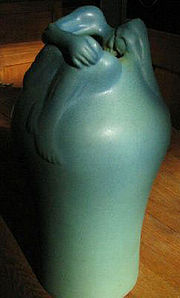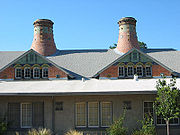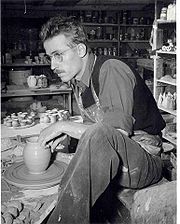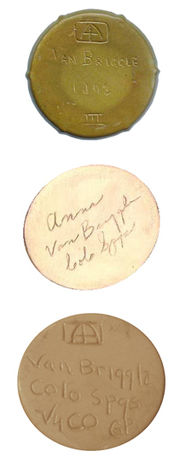
Van Briggle Pottery
Encyclopedia
Established in Colorado Springs, Colorado
in 1901 by Artus and Anne Van Briggle, the Van Briggle Art Pottery is the oldest continuously operating art pottery
in the United States. Artus Van Briggle had a significant impact on the Art Nouveau
movement in the United States, and his pottery is foundational to American Art Pottery. The Art Nouveau style favored by its founders continues to influence the pottery's designs.
Artus Van Briggle settled in Colorado Springs in 1899 after establishing himself as a notable artist with the Rookwood Pottery of Ohio. With Anne Louise (née Gregory), his new wife, Artus began exploring the Art Nouveau style in their pottery
creations, drawing awards and accolades from the American and European art communities. Although he was a talented painter who had displayed and won awards in Europe, from 1899 until his death Artus devoted himself almost exclusively to the craft and art of pottery. Van Briggle's Art Nouveau designs and distinctive matte glazes were awarded high honors from prestigious sources, including the Paris Salon
, the Saint Louis Exposition
, the Lewis and Clark Centennial Exposition
, and the American Arts and Crafts Exhibition in Boston.
 Born to artistic parents on March 21, 1869, Artus Van Briggle had an early introduction to painting using materials found about the home. The Van Briggle family lived in Ohio, one of America's hotbeds of ceramic design. At the age of 17 he moved to Cincinnati, Ohio
Born to artistic parents on March 21, 1869, Artus Van Briggle had an early introduction to painting using materials found about the home. The Van Briggle family lived in Ohio, one of America's hotbeds of ceramic design. At the age of 17 he moved to Cincinnati, Ohio
, where he decorated china dolls at the Arnold Fairyland Doll Store, while attending his early art studies at the Cincinnati Art School. After a stint at the Avon Pottery where he was introduced to the ceramic arts, Artus took a job at Rookwood Pottery; there he excelled at hand-painting designs. His skill and talent were recognized by Rookwood founder, Maria Storer, who became his benefactor, even sending him to France to study art at the Académie Julian
in Paris.
In Europe, he was exposed to styles of art and became infatuated with an early matte
glaze
from the Chinese Ming Dynasty
; a type that was lost to history. Artus also met his future wife, fellow American student Anne Lawrence Gregory, an accomplished artist in her own right. Finishing their Paris studies in 1896, they returned to America. Artus resumed his work at Rookwood and also started sculpting and experimented with recreating the lost Ming Dynasty glazes.

, Artus left Rookwood and moved to the drier air of Colorado Springs, Colorado. In Colorado, he pursued his own styles of pottery, centered around the Art Nouveau movement, and to continue his research on the ancient matte glazes that had fascinated him in Paris. After two years of trials and experiments a matte glaze was perfected. One of the matte glazes perfected by Artus was the matte blue glaze, based on an ancient Chinese process that had long been lost to history.
Artus opened Van Briggle Pottery in 1901 and was joined by Anne Gregory, who took a position as a high school art teacher in Colorado Springs. In 1903, Artus Van Briggle was appointed First Director of the Department of Art and Design in Colorado College, succeeding Louis Soutter, a Swiss artist (born in Geneva, Switzerland) he met in Paris in 1895.
In 1902, Anne and Artus were married, and she devoted herself to their pottery; she created designs and collaborated in all aspects of the enterprise with her husband. Late 1902 brought Van Briggle awards for his glazes and designs in Art Nouveau from the prestigious Paris Salon; he was now an accepted artist. During their early years, Artus and Ann established hundreds of Art Nouveau styles of pottery under the Van Briggle name. The Despondency vase won Van Briggle wide acclaim and first place at the Paris Salon in 1903. A display at the 1904 Centennial Exhibit in St. Louis won Van Briggle more awards and greater international fame.

began construction on a new pottery on Uintah Street. The Van Briggle Memorial Pottery — designed by Dutch architect
Nicholas Van den Arend — was opened in 1908 and stands today as an historic landmark noted for its architecture and use of ceramics in the facade.
Having remarried in 1908, Anne Louise Gregory Ritter leased the pottery in 1910 to Edmund deForest Curtis and moved to Denver, where she would concentrate on painting and where she remained until her death in 1929. In her absence, the pottery fell under financial hardships and was sold at sheriff's auction; later it was re-sold, once more becoming the property of Mr. Curtis.
s. New owners I.F. and J.H. Lewis took the opportunity to modernize and expand the facility beginning in 1920 and stabilized the production and financial aspects of the pottery for the first time. Despite a flood in 1935 that destroyed much of the company's records and moulds, the pottery continued to enjoy success up to World War II
, when they closed for approximately three years as the United States focused its resources on defeating fascism
.
With the increase of internal travel in the United States a freeway was planned in 1953 for Colorado Springs which J.H. Lewis estimated would run through the Memorial Plant site. Although the freeway eventually was planned to avoid destroying the historic pottery, Mr. Lewis nonetheless put into action plans to relocate the pottery to a higher-traffic area of Colorado Springs. In 1955, Mr. Lewis and Clem Hull brought a new facility on line at a renovated railroad roundhouse
on Midland Road. The new facility, known as the Midland Plant, had a smaller capacity but enjoyed quick success due to its location on the main highway to the Garden of the Gods
and other tourist locations.
In 1968, Mr. Lewis sold the Memorial Plant to Colorado College
, and it fell into disrepair for the ensuing 40 years, being used variously as offices and storage.

Mr. Stevenson died in 1990, leaving the pottery to his wife Bertha Stevenson and their son Craig A. Stevenson, now Van Briggle's chief designer. "If Artus Van Briggle walked in and saw our production facility today," according to Craig Stevenson, "he would certainly recognize a lot of what we're doing."
Potters who have worked at Van Briggle include Ambrose Schlegel, Harry Bangs, Nellie Walker
, William Higman, Clem Hull, Gene Hopkins, Fred Wills, Nelson Curtis, Joe Jezek, Craig Stevenson, Mark Sucharski, and Becky Hansen.

The Van Briggle logo consists of a pair of conjoined A's inside a box, and is featured on most — but not all — Van Briggle pottery. Other marks that might appear on the bottom of their pottery include the text, "Van Briggle", "Colorado Springs, Colorado" most frequently abbreviated, artist marks indicating the artist who threw the piece or finished it, or both, clay batch numbers, and year of manufacture indicators. The variety of marks is broad and beyond the scope of an encyclopedia article to list.
Colorado Springs, Colorado
Colorado Springs is a Home Rule Municipality that is the county seat and most populous city of El Paso County, Colorado, United States. Colorado Springs is located in South-Central Colorado, in the southern portion of the state. It is situated on Fountain Creek and is located south of the Colorado...
in 1901 by Artus and Anne Van Briggle, the Van Briggle Art Pottery is the oldest continuously operating art pottery
Pottery
Pottery is the material from which the potteryware is made, of which major types include earthenware, stoneware and porcelain. The place where such wares are made is also called a pottery . Pottery also refers to the art or craft of the potter or the manufacture of pottery...
in the United States. Artus Van Briggle had a significant impact on the Art Nouveau
Art Nouveau
Art Nouveau is an international philosophy and style of art, architecture and applied art—especially the decorative arts—that were most popular during 1890–1910. The name "Art Nouveau" is French for "new art"...
movement in the United States, and his pottery is foundational to American Art Pottery. The Art Nouveau style favored by its founders continues to influence the pottery's designs.
Artus Van Briggle settled in Colorado Springs in 1899 after establishing himself as a notable artist with the Rookwood Pottery of Ohio. With Anne Louise (née Gregory), his new wife, Artus began exploring the Art Nouveau style in their pottery
Pottery
Pottery is the material from which the potteryware is made, of which major types include earthenware, stoneware and porcelain. The place where such wares are made is also called a pottery . Pottery also refers to the art or craft of the potter or the manufacture of pottery...
creations, drawing awards and accolades from the American and European art communities. Although he was a talented painter who had displayed and won awards in Europe, from 1899 until his death Artus devoted himself almost exclusively to the craft and art of pottery. Van Briggle's Art Nouveau designs and distinctive matte glazes were awarded high honors from prestigious sources, including the Paris Salon
Paris Salon
The Salon , or rarely Paris Salon , beginning in 1725 was the official art exhibition of the Académie des Beaux-Arts in Paris, France. Between 1748–1890 it was the greatest annual or biannual art event in the Western world...
, the Saint Louis Exposition
Louisiana Purchase Exposition
The Louisiana Purchase Exposition, informally known as the Saint Louis World's Fair, was an international exposition held in St. Louis, Missouri, United States in 1904.- Background :...
, the Lewis and Clark Centennial Exposition
Lewis and Clark Centennial Exposition
The Lewis and Clark Centennial Exposition, commonly also known as the Lewis and Clark Exposition, and officially known as the Lewis and Clark Centennial American Pacific Exposition and Oriental Fair, was a worldwide exposition held in Portland, Oregon, United States in 1905 to celebrate the...
, and the American Arts and Crafts Exhibition in Boston.
Early artistic career and studies

Cincinnati, Ohio
Cincinnati is a city in the U.S. state of Ohio. Cincinnati is the county seat of Hamilton County. Settled in 1788, the city is located to north of the Ohio River at the Ohio-Kentucky border, near Indiana. The population within city limits is 296,943 according to the 2010 census, making it Ohio's...
, where he decorated china dolls at the Arnold Fairyland Doll Store, while attending his early art studies at the Cincinnati Art School. After a stint at the Avon Pottery where he was introduced to the ceramic arts, Artus took a job at Rookwood Pottery; there he excelled at hand-painting designs. His skill and talent were recognized by Rookwood founder, Maria Storer, who became his benefactor, even sending him to France to study art at the Académie Julian
Académie Julian
The Académie Julian was an art school in Paris, France.Rodolphe Julian established the Académie Julian in 1868 at the Passage des Panoramas, as a private studio school for art students. The Académie Julian not only prepared students to the exams at the prestigious École des Beaux-Arts, but offered...
in Paris.
In Europe, he was exposed to styles of art and became infatuated with an early matte
Gloss (material appearance)
Gloss is an optical property, which is based on the interaction of light with physical characteristics of a surface. It is actually the ability of a surface to reflect light into the specular direction. The factors that affect gloss are the refractive index of the material, the angle of incident...
glaze
Ceramic glaze
Glaze is a layer or coating of a vitreous substance which has been fired to fuse to a ceramic object to color, decorate, strengthen or waterproof it.-Use:...
from the Chinese Ming Dynasty
Ming Dynasty
The Ming Dynasty, also Empire of the Great Ming, was the ruling dynasty of China from 1368 to 1644, following the collapse of the Mongol-led Yuan Dynasty. The Ming, "one of the greatest eras of orderly government and social stability in human history", was the last dynasty in China ruled by ethnic...
; a type that was lost to history. Artus also met his future wife, fellow American student Anne Lawrence Gregory, an accomplished artist in her own right. Finishing their Paris studies in 1896, they returned to America. Artus resumed his work at Rookwood and also started sculpting and experimented with recreating the lost Ming Dynasty glazes.

Perfecting the distinctive dull or matte glaze
In 1899, struggling with health issues due to tuberculosisTuberculosis
Tuberculosis, MTB, or TB is a common, and in many cases lethal, infectious disease caused by various strains of mycobacteria, usually Mycobacterium tuberculosis. Tuberculosis usually attacks the lungs but can also affect other parts of the body...
, Artus left Rookwood and moved to the drier air of Colorado Springs, Colorado. In Colorado, he pursued his own styles of pottery, centered around the Art Nouveau movement, and to continue his research on the ancient matte glazes that had fascinated him in Paris. After two years of trials and experiments a matte glaze was perfected. One of the matte glazes perfected by Artus was the matte blue glaze, based on an ancient Chinese process that had long been lost to history.
Artus opened Van Briggle Pottery in 1901 and was joined by Anne Gregory, who took a position as a high school art teacher in Colorado Springs. In 1903, Artus Van Briggle was appointed First Director of the Department of Art and Design in Colorado College, succeeding Louis Soutter, a Swiss artist (born in Geneva, Switzerland) he met in Paris in 1895.
In 1902, Anne and Artus were married, and she devoted herself to their pottery; she created designs and collaborated in all aspects of the enterprise with her husband. Late 1902 brought Van Briggle awards for his glazes and designs in Art Nouveau from the prestigious Paris Salon; he was now an accepted artist. During their early years, Artus and Ann established hundreds of Art Nouveau styles of pottery under the Van Briggle name. The Despondency vase won Van Briggle wide acclaim and first place at the Paris Salon in 1903. A display at the 1904 Centennial Exhibit in St. Louis won Van Briggle more awards and greater international fame.

Pottery loses its founder
Artus Van Briggle died in July 1904, at the age of 35. Anne continued the pottery using the forms created by Artus as a foundation and adding more designs of her own. In 1907, Anne and pottery stockholder and city-founder William Jackson PalmerWilliam Jackson Palmer
William Jackson Palmer was an American civil engineer, soldier, industrialist, and philanthropist.-Overview:...
began construction on a new pottery on Uintah Street. The Van Briggle Memorial Pottery — designed by Dutch architect
Architect
An architect is a person trained in the planning, design and oversight of the construction of buildings. To practice architecture means to offer or render services in connection with the design and construction of a building, or group of buildings and the space within the site surrounding the...
Nicholas Van den Arend — was opened in 1908 and stands today as an historic landmark noted for its architecture and use of ceramics in the facade.
Having remarried in 1908, Anne Louise Gregory Ritter leased the pottery in 1910 to Edmund deForest Curtis and moved to Denver, where she would concentrate on painting and where she remained until her death in 1929. In her absence, the pottery fell under financial hardships and was sold at sheriff's auction; later it was re-sold, once more becoming the property of Mr. Curtis.
Surviving disaster and war
The pottery was sold twice more in the ensuing decade and survived a fire in 1919 that gutted the interior but left the brick shell and kilnKiln
A kiln is a thermally insulated chamber, or oven, in which a controlled temperature regime is produced. Uses include the hardening, burning or drying of materials...
s. New owners I.F. and J.H. Lewis took the opportunity to modernize and expand the facility beginning in 1920 and stabilized the production and financial aspects of the pottery for the first time. Despite a flood in 1935 that destroyed much of the company's records and moulds, the pottery continued to enjoy success up to World War II
World War II
World War II, or the Second World War , was a global conflict lasting from 1939 to 1945, involving most of the world's nations—including all of the great powers—eventually forming two opposing military alliances: the Allies and the Axis...
, when they closed for approximately three years as the United States focused its resources on defeating fascism
Fascism
Fascism is a radical authoritarian nationalist political ideology. Fascists seek to rejuvenate their nation based on commitment to the national community as an organic entity, in which individuals are bound together in national identity by suprapersonal connections of ancestry, culture, and blood...
.
With the increase of internal travel in the United States a freeway was planned in 1953 for Colorado Springs which J.H. Lewis estimated would run through the Memorial Plant site. Although the freeway eventually was planned to avoid destroying the historic pottery, Mr. Lewis nonetheless put into action plans to relocate the pottery to a higher-traffic area of Colorado Springs. In 1955, Mr. Lewis and Clem Hull brought a new facility on line at a renovated railroad roundhouse
Roundhouse
A roundhouse is a building used by railroads for servicing locomotives. Roundhouses are large, circular or semicircular structures that were traditionally located surrounding or adjacent to turntables...
on Midland Road. The new facility, known as the Midland Plant, had a smaller capacity but enjoyed quick success due to its location on the main highway to the Garden of the Gods
Garden of the Gods
Garden of the Gods is a public park located in Colorado Springs, Colorado, USA.-Genesis of the park:Entrance to the park is free according to the wish of Charles Elliott Perkins, whose children donated the land to the city of Colorado Springs in 1909....
and other tourist locations.
In 1968, Mr. Lewis sold the Memorial Plant to Colorado College
Colorado College
The Colorado College is a private liberal arts college in Colorado Springs, Colorado, United States, in the foothills of the Rocky Mountains. It was founded in 1874 by Thomas Nelson Haskell...
, and it fell into disrepair for the ensuing 40 years, being used variously as offices and storage.

New era
American tastes in the 1950s turned to modern designs and all things glossy, so Van Briggle embarked on a new era which saw the pottery continue to produce the traditional matte glazes and Art Nouveau designs, but which also saw the introduction of more trendy gloss glazes and modern designs. Longtime employee Kenneth Stevenson took majority control of the company in 1969, and the pottery continued to produce two distinct lines and enjoyed a period of expansion and relative stability under the production supervision of Fred Wills.Mr. Stevenson died in 1990, leaving the pottery to his wife Bertha Stevenson and their son Craig A. Stevenson, now Van Briggle's chief designer. "If Artus Van Briggle walked in and saw our production facility today," according to Craig Stevenson, "he would certainly recognize a lot of what we're doing."
Notable artists
Throughout its history, Van Briggle Pottery has attracted talented artisans and, since at least the 1930s, has featured tours and live displays of potters "throwing on the wheel."Potter's wheel
In pottery, a potter's wheel is a machine used in asma of round ceramic ware. The wheel may also be used during process of trimming the excess body from dried ware and for applying incised decoration or rings of color...
Potters who have worked at Van Briggle include Ambrose Schlegel, Harry Bangs, Nellie Walker
Nellie Walker
Nellie Verne Walker , was an American sculptor best known for her statue of James Harlan in the National Statuary Hall Collection in the United States Capitol, Washington D.C.-Early years:...
, William Higman, Clem Hull, Gene Hopkins, Fred Wills, Nelson Curtis, Joe Jezek, Craig Stevenson, Mark Sucharski, and Becky Hansen.

Identification
Collectors identify Van Briggle pottery by its distinctive glazes, shapes, and bottom markings. At left are samples of typical Van Briggle bottoms markings. Most such marks were hand-incised, so varied over time and between individuals.The Van Briggle logo consists of a pair of conjoined A's inside a box, and is featured on most — but not all — Van Briggle pottery. Other marks that might appear on the bottom of their pottery include the text, "Van Briggle", "Colorado Springs, Colorado" most frequently abbreviated, artist marks indicating the artist who threw the piece or finished it, or both, clay batch numbers, and year of manufacture indicators. The variety of marks is broad and beyond the scope of an encyclopedia article to list.
Sources
Van Briggle Pottery- The Collector's Encyclopedia of Van Briggle by Richard Sasicki & Josie Fania
- The Story Behind The Clay by David & Sharon Swint
- The Clement Marot Hull Memorial Association
- The Colorado Springs Gazette
- The Collector's Guide to Van Briggle Pottery by Scott Nelson and Lois Crouch
- The Van Briggle Story by Dorothy McGraw Bogue
See also
- Arts and Crafts MovementArts and Crafts movementArts and Crafts was an international design philosophy that originated in England and flourished between 1860 and 1910 , continuing its influence until the 1930s...
- Pewabic PotteryPewabic PotteryPewabic Pottery is a studio and school located in Detroit, Michigan and founded in 1903. The studio is known for its iridescent glazes, some of which grace notable buildings such as the Shedd Aquarium and Basilica of the National Shrine of the Immaculate Conception. Pewabic Pottery is on display...
- Niloak PotteryNiloak PotteryNiloak is a line of pottery produced by the Eagle Pottery Company of Benton, Arkansas. Eagle was founded by Charles Dean Hyten and his brothers in the 1890s and was the largest pottery-ware business in the Benton area by 1904....
- PotteryPotteryPottery is the material from which the potteryware is made, of which major types include earthenware, stoneware and porcelain. The place where such wares are made is also called a pottery . Pottery also refers to the art or craft of the potter or the manufacture of pottery...
- Studio potteryStudio potteryStudio pottery is made by modern artists working alone or in small groups, producing unique items of pottery in small quantities, typically with all stages of manufacture carried out by one individual. Much studio pottery is tableware or cookware but an increasing number of studio potters produce...

